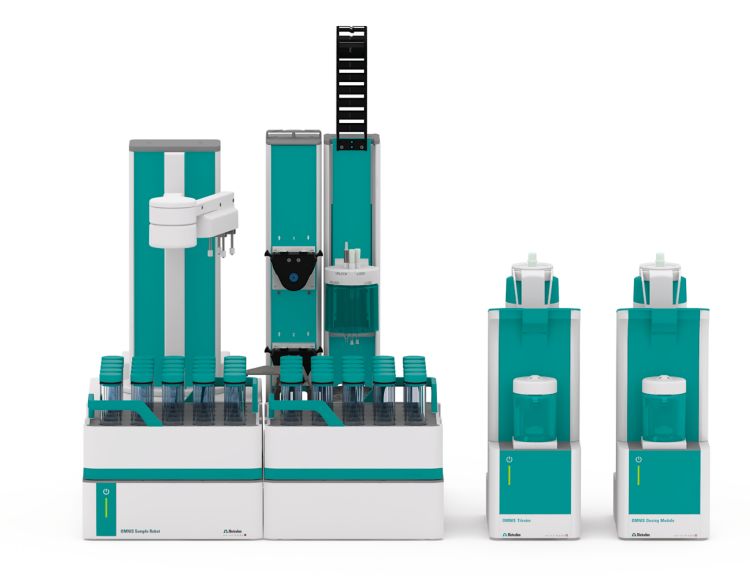The presence of acidic components in volatile solvents is due to contamination of the solvents, or through their decomposition during storage, distribution, or manufacture. Increased acid content in solvents could lead to a variety of problems like shorter storage stability or chemical corrosion, which can damage costly company assets and lead to shutdowns.
Using the Optrode for indication, the acidity is determined according to ASTM D1613 by photometric titration with sodium hydroxide as titrant and phenolphthalein as indicator. The Optrode enables an objective recognition of the end point enhancing the accuracy of the results.
The analysis is demonstrated on 4-methyl-2-pentanone (MIBK), 2-ethoxyethyl acetate, and 2-ethoxyethanol.

The analysis is carried out fully automatically on an OMNIS system consisting of an OMNIS Sample Robot, an OMNIS Advanced Titrator, and an OMNIS Dosing Module. The Optrode is used for indication of the end point.
For water-soluble samples (e.g., 2-ethoxyethanol), an appropriate amount of sample is pipetted into the sample beaker. While stirring, deionized water is dosed and phenolphthalein indicator solution is pipetted into the sample beaker. The solution is then titrated with standardized sodium hydroxide until after the end point is reached. After each titration, the titrated solution is aspirated and the buret tips as well as the sensor are rinsed with deionized water in the sample beaker.
For samples that are not completely miscible in water (e.g., MIBK or 2-ethoxyethyl acetate), the same procedure is used as for water-soluble samples with the exception that carbon-dioxide free ethanol is used instead of deionized water.
Color changes are produced which are detected objectively with the Optrode and reliably evaluated by the OMNIS Software.
| Substance | Mean value / % | SD(abs) / % | SD(rel) / % |
|---|---|---|---|
| 4-methyl-2-pentanone | 0.0151 | 6.0 ∙ 10-5 | 0.4 |
| 2-ethoxyethyl acetate | 0.012 | 8.0 ∙ 10-5 | 0.7 |
| 2-ethoxyethanol | 0.0003 | 1.6 ∙ 10-5 | 5.2 |
This method shows the possibility to determine very low acidity according to ASTM D1613. The standard deviation is acceptable even at very low acidities due to the objective and reproducible detection of the color change by the Optrode.
With the possibility to easily change between 8 different wavelengths, the Optrode can be used for other applications. The fully automated OMNIS system allows to enhance the throughput of the analyses and enabling the best possible results.
Internal reference: AW TI CH1-1254-112018
 แชร์ แอปพลิเคชั่น
แชร์ แอปพลิเคชั่น
 ดาวน์โหลด PDF
ดาวน์โหลด PDF